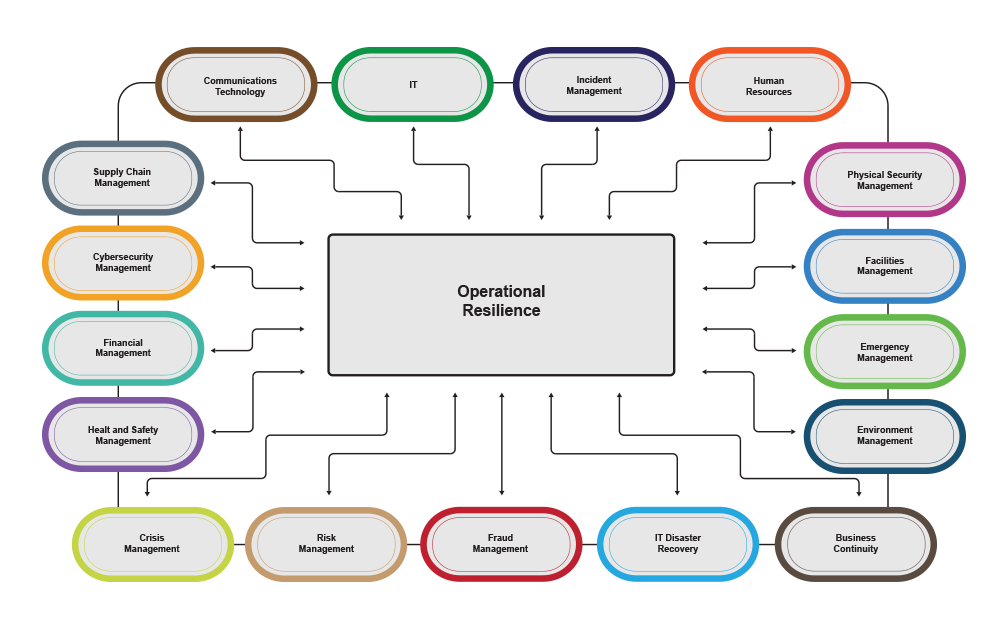
 Two structures are typically organised to manage the operational resilience effort within an organisation.
Two structures are typically organised to manage the operational resilience effort within an organisation.
- One is the "peace-time" governance and program management team.
- Another set of teams with the organisation structure ensures that an organization can manage disruptions effectively.
Each team member has specific roles and responsibilities contributing to the program's success.
In this blog, we will highlight who should be part of the operational resilience team and explain the roles and responsibilities of each team member.
Roles and Responsibilities of the Governance and Progam Management Team
|
Peace-time Appointment Holders
|
| Board of Directors |
- Is responsible for overseeing the organization's overall strategy
- Ensure that it is aligned with the organization's goals and objectives.
- Provide guidance and support to the senior management team
- Ensure that the organization's operational resilience program is effective and aligned with the organization's strategic objectives.
|
| Senior Management |
- is responsible for overseeing the day-to-day operations of the organization
- Ensure that the organization can manage disruptions effectively.
- Provide leadership and support to the operational resilience team
- Ensure that the team is aligned with the organization's strategic objectives.
|
| Executive Sponsor |
- is a senior-level executive who provides leadership and support for the operational resilience program.
- Responsible for ensuring the program aligns with the organization's goals and objectives.
- Responsible for securing the necessary resources and funding to support the program.
|
| Program Manager |
- Responsible for the overall management and coordination of the operational resilience program.
- Responsible for developing and implementing the program's strategy, policies, and procedures.
- Ensures that the program complies with regulatory requirements and industry standards.
|

Roles and Responsibilities of the Operational Resilience Team
| Operational Resilience Team |
| Risk Management |
- Identify, assess, and manage the organization's risks that could negatively impact its ability to deliver its services.
- Develops risk management strategies and policies
- Work with other team members to address these risks in the operational resilience program.
|
| Business Continuity |
- Responsible for developing and maintaining the organization's Business Continuity Plan and Program.
- Identify critical business functions and processes, and develop strategies and procedures to ensure these functions and processes can continue during a disruption.
- Ensures the plan is regularly tested and updated to ensure the organization is prepared to manage disruptions effectively.
|
|
IT Disaster Recovery
|
-
Responsible for developing and maintaining the organization's IT Disaster Recovery Plan (DRP).
-
Ensures that critical IT systems and infrastructure can continue to operate in the event of a disruption and work closely with the Business Continuity team to ensure that the organization can continue to deliver its critical business services.
- Ensures that the plan is regularly tested and updated to ensure that the organization's IT systems and infrastructure can continue to operate in the event of a disruption.
|
| Crisis Management |
- Responsible for managing crises and ensuring the organization can respond effectively.
- Develop crisis management strategies and policies, and work closely with the Incident Management and Emergency Management teams to ensure that the organization can respond to crises in a coordinated and effective manner.
|
|
Incident Management:
|
- Responsible for managing disruptions when they occur.
- Ensure that the organization's response is timely, effective, and in line with the organization's policies and procedures.
- Coordinate with other members of the operational resilience team to ensure a coordinated response to the disruption.
|
|
Emergency Management
|
- Responsible for managing emergencies and ensuring that the organization can respond effectively.
- Develop emergency management strategies and policies.
- Work closely with the Incident Management and Crisis Management teams to ensure that the organization can respond to emergencies in a coordinated and effective manner.
|
|
Security
|
- Responsible for ensuring the security of the organization's physical assets, information, and employees.
- Develop security policies and procedures, and work closely with the Facility and IT teams to ensure the organization is secure from physical and cyber threats.
|
|
Facility
|
- Manage the organization's physical assets, such as buildings and equipment.
- Ensure that these assets are maintained and operational.
- Work closely with the Security and Health and Safety teams to ensure the organization is secure and compliant with safety regulations.
|
|
Health and Safety
|
- Responsible for ensuring that the organization complies with health and safety regulations and provides employees with a safe and healthy working environment.
- Develop health and safety policies and procedures.
- Work closely with the Facility and Security teams to ensure the organization is secure and compliant with safety regulations.
|
|
IT
|
- Responsible for managing the organization's IT systems and infrastructure. They ensure that these systems are maintained and operational.
- Work closely with the IT Disaster Recovery and Business Continuity teams to ensure that the organization can continue to deliver its services in the event of a disruption.
|
|
Communication
|
- Responsible for developing and implementing the organization's communication strategy during a disruption.
- Ensure that all stakeholders are informed about the disruption and that the organization's response is communicated effectively.
|
|
Fraud Management
|
- Responsible for preventing, detecting, and responding to fraudulent activities that could impact the organization.
- Develop and implement fraud management policies and procedures.
- Work closely with the Risk Management and Incident Management teams to identify and mitigate fraud risks.
|
|
Data
|
- Responsible for managing the organization's data assets and ensuring data is available, accurate, and secure.
- Develop and implement data management policies and procedures.
- Work closely with the Cybersecurity Management team to protect data from cyber threats.
|
|
Cybersecurity Management
|
- Responsible for managing the organization's cybersecurity risks and ensuring that the organization is protected from cyber threats.
- Develop and implement cybersecurity policies and procedures.
- Work closely with the Data and IT teams to ensure the organization's systems and data are secure.
|
|
Human Resource
|
- Responsible for managing the organization's workforce.
- Ensure that employees are trained and prepared to respond to disruptions.
- Develop and implement HR policies and procedures,
- Work closely with the Incident Management and Crisis Management teams to ensure employees know their roles and responsibilities during disruptions.
|
|
|
Finally ...
In conclusion, the operational resilience team is critical in ensuring an organization can manage disruptions effectively.
Each team member has a specific role and responsibility contributing to the program's success.
By understanding who should be part of the operational resilience team and their roles and responsibilities, organizations can develop a comprehensive and effective operational resilience program to manage disruptions effectively.
Learn more about Blended Learning OR-300 [BL-OR-3] and OR-5000 [BL-OR-5]
To learn more about the course and schedule, click the buttons below for the OR-3 Blended Learning OR-300 Operational Resilience Implementer course and the OR-5 Blended Learning OR-5000 Operational Resilience Expert Implementer course.
 |
 |
 |
 |
 |
![[BL-OR] [3-4-5] View Schedule](https://no-cache.hubspot.com/cta/default/3893111/d0d733a1-16c0-4b68-a26d-adbfd4fc6069.png) |
![[BL-OR] [3] FAQ OR-300](https://no-cache.hubspot.com/cta/default/3893111/f20c71b4-f5e8-4aa5-8056-c374ca33a091.png) |
If you have any questions, click to contact us.![Email to Sales Team [BCM Institute]](https://no-cache.hubspot.com/cta/default/3893111/3c53daeb-2836-4843-b0e0-645baee2ab9e.png) |

|
 Two structures are typically organised to manage the operational resilience effort within an organisation.
Two structures are typically organised to manage the operational resilience effort within an organisation.




![[BL-OR] [3-4-5] View Schedule](https://no-cache.hubspot.com/cta/default/3893111/d0d733a1-16c0-4b68-a26d-adbfd4fc6069.png)
![[BL-OR] [3] FAQ OR-300](https://no-cache.hubspot.com/cta/default/3893111/f20c71b4-f5e8-4aa5-8056-c374ca33a091.png)
![Email to Sales Team [BCM Institute]](https://no-cache.hubspot.com/cta/default/3893111/3c53daeb-2836-4843-b0e0-645baee2ab9e.png)






